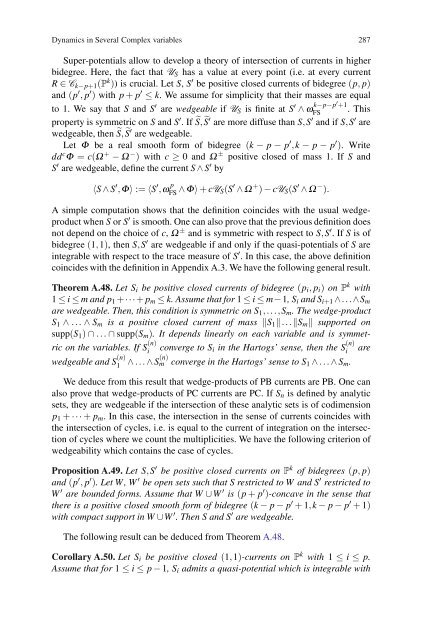Discrete Holomorphic Local Dynamical Systems
Discrete Holomorphic Local Dynamical Systems
Discrete Holomorphic Local Dynamical Systems
You also want an ePaper? Increase the reach of your titles
YUMPU automatically turns print PDFs into web optimized ePapers that Google loves.
Dynamics in Several Complex variables 287<br />
Super-potentials allow to develop a theory of intersection of currents in higher<br />
bidegree. Here, the fact that US has a value at every point (i.e. at every current<br />
R ∈ Ck−p+1(Pk )) is crucial. Let S, S ′ be positive closed currents of bidegree (p, p)<br />
and (p ′ , p ′ ) with p + p ′ ≤ k. We assume for simplicity that their masses are equal<br />
to 1. We say that S and S ′ are wedgeable if US is finite at S ′ ∧ ω k−p−p′ +1<br />
FS .This<br />
property is symmetric on S and S ′ .If�S, �S ′ are more diffuse than S,S ′ and if S,S ′ are<br />
wedgeable, then �S, �S ′ are wedgeable.<br />
Let Φ be a real smooth form of bidegree (k − p − p ′ ,k − p − p ′ ). Write<br />
ddcΦ = c(Ω + − Ω − ) with c ≥ 0andΩ ± positive closed of mass 1. If S and<br />
S ′ are wedgeable, define the current S ∧ S ′ by<br />
〈S ∧ S ′ ,Φ〉 := 〈S ′ ,ω p<br />
FS ∧ Φ〉 + cUS(S ′ ∧ Ω + ) − cUS(S ′ ∧ Ω − ).<br />
A simple computation shows that the definition coincides with the usual wedgeproduct<br />
when S or S ′ is smooth. One can also prove that the previous definition does<br />
not depend on the choice of c, Ω ± and is symmetric with respect to S,S ′ .IfS is of<br />
bidegree (1,1), thenS,S ′ are wedgeable if and only if the quasi-potentials of S are<br />
integrable with respect to the trace measure of S ′ . In this case, the above definition<br />
coincides with the definition in Appendix A.3. We have the following general result.<br />
Theorem A.48. Let Si be positive closed currents of bidegree (pi, pi) on P k with<br />
1 ≤ i ≤ m and p1 +···+ pm ≤ k. Assume that for 1 ≤ i ≤ m−1,Si and Si+1 ∧...∧Sm<br />
are wedgeable. Then, this condition is symmetric on S1,...,Sm. The wedge-product<br />
S1 ∧ ... ∧ Sm is a positive closed current of mass �S1�...�Sm� supported on<br />
supp(S1) ∩ ...∩ supp(Sm). It depends linearly on each variable and is symmet-<br />
ric on the variables. If S (n)<br />
i converge to Si in the Hartogs’ sense, then the S (n)<br />
i are<br />
wedgeable and S (n)<br />
1<br />
∧ ...∧ S(n)<br />
m converge in the Hartogs’ sense to S1 ∧ ...∧ Sm.<br />
We deduce from this result that wedge-products of PB currents are PB. One can<br />
also prove that wedge-products of PC currents are PC. If Sn is defined by analytic<br />
sets, they are wedgeable if the intersection of these analytic sets is of codimension<br />
p1 + ···+ pm. In this case, the intersection in the sense of currents coincides with<br />
the intersection of cycles, i.e. is equal to the current of integration on the intersection<br />
of cycles where we count the multiplicities. We have the following criterion of<br />
wedgeability which contains the case of cycles.<br />
Proposition A.49. Let S,S ′ be positive closed currents on P k of bidegrees (p, p)<br />
and (p ′ , p ′ ).LetW,W ′ be open sets such that S restricted to W and S ′ restricted to<br />
W ′ are bounded forms. Assume that W ∪W ′ is (p + p ′ )-concave in the sense that<br />
there is a positive closed smooth form of bidegree (k − p − p ′ + 1,k − p − p ′ + 1)<br />
with compact support in W ∪W ′ . Then S and S ′ are wedgeable.<br />
The following result can be deduced from Theorem A.48.<br />
Corollary A.50. Let Si be positive closed (1,1)-currents on P k with 1 ≤ i ≤ p.<br />
Assume that for 1 ≤ i ≤ p − 1, Si admits a quasi-potential which is integrable with



